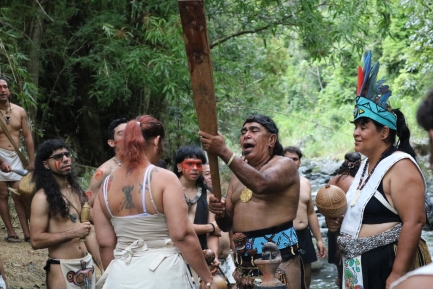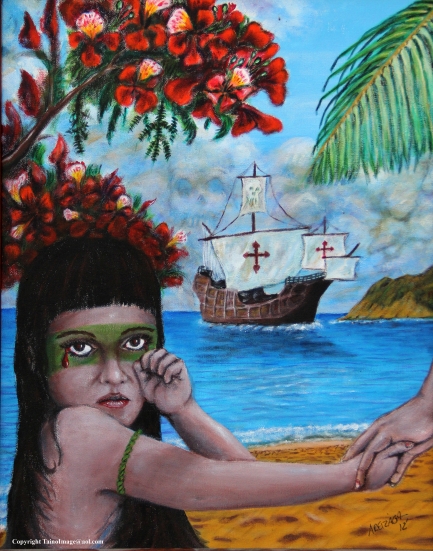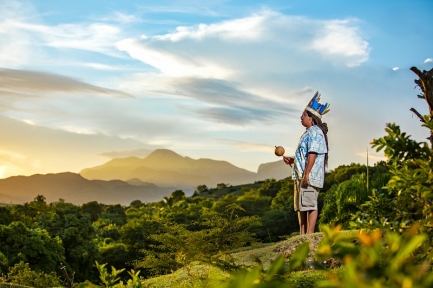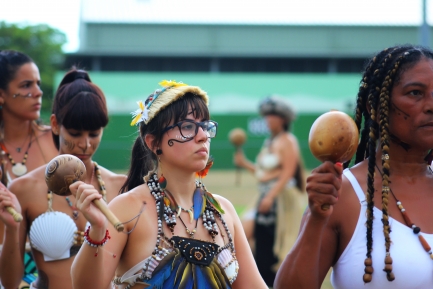Woman receiving her Taíno name during a Taíno religious public ceremony by community Concilio Taíno Guatu-ma-cu-a-Boriken. Guayanilla, Puerto Rico, 2018.
Indigenous Legacy of the Caribbean Featured in New Smithsonian Exhibition
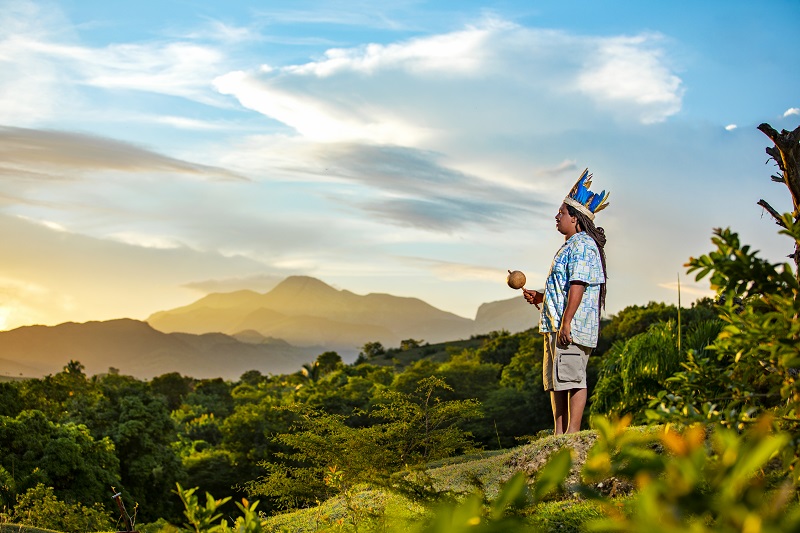
Boynayel Mota, of the music and cultural group Taiguabo Yukayeke Kiskeya, overlooks the mountains of his Indigenous ancestors in Maguana Arriba, Dominican Republic. Photo by Delvin Ortega, Ortega Films, Dominican Republic, Aug. 17, 2021.
The history of the Taínos, the Indigenous peoples of the northern Caribbean islands, and how their descendants are reaffirming their culture and identity today is the focus of a new Smithsonian exhibition that will begin a national tour May 13 at the Museum of Arts and Sciences in Daytona Beach, Florida. “Caribbean Indigenous Resistance / Resistencia indígena del Caribe ¡Taíno Vive!” will be on view at the Smithsonian Affiliate through Aug. 6. The exhibition is organized for travel by the Smithsonian Institution Traveling Exhibition Service (SITES) in collaboration with the National Museum of the American Indian and the National Museum of the American Latino.
The bilingual (English/Spanish) exhibition explores the rich and enduring cultural legacies of the Taínos and the complicated questions around heritage, ancestry and race that emerge from Taíno identities today. The term Taíno refers to the diverse Arawak-speaking peoples of the Greater Antilles (Cuba, Jamaica, Haiti, the Dominican Republic and Puerto Rico) and their descendants within and outside of the Caribbean. In 1492, the Taíno discovered Christopher Columbus, an encounter that set in motion a Spanish invasion that devastated the Taíno civilization and decimated their population. However, the exhibition reveals that in places like Puerto Rico, Cuba and Jamaica, historical records and regional traditions point to Indigenous survival and rich cultural legacies within and outside the Caribbean.
“This exhibition tells the story of the Caribbean from the perspective of Indigenous survival and resistance,” said María del Carmen Cossu, project manager for Latino Initiatives at SITES. “It is dedicated to understand the value and impact of the Taíno legacy that continues to live on through its descendants, the community and activist groups.”
“Caribbean Indigenous Resistance / Resistencia indígena del Caribe ¡Taíno Vive!” explores the Taíno heritage of today and how Taíno descendants are participating in a growing movement to reaffirm their Caribbean Indigenous identity and culture. Visitors will learn about the Taíno survival journey through stories, contemporary crafts, musical instruments and utilitarian objects associated with aspects of Native day-to-day life. The exhibition includes a short video that showcases the impacts of colonial encounters in the Caribbean and the nexus of the first interactions between the new and the old world.
Visitors will discover examples of Indigenous musical instruments such as the maracas and the güiro, traditionally made from the dritas fruit of the Higuera tree, native to parts of Central America and Puerto Rico. Contemporary objects such as jícara bowls show the traditional eating and drinking utensils first used by the Taínos that were made from the fruit of the gourd tree.
This exhibition received federal support from the Latino Initiatives Pool, administered by the National Museum of the American Latino.
The Smithsonian Institution Traveling Exhibition Service (SITES) and Smithsonian Affiliations are critical national outreach units at the Smithsonian Institution. For more than 70 years, SITES has been connecting Americans to their shared cultural heritage through a wide range of exhibitions about art, science and history. Smithsonian Affiliations establishes and maintains the Smithsonian’s long-term partnerships with museums, educational organizations and cultural institutions in the U.S., Puerto Rico and Panama. Together, SITES and Affiliations share the Smithsonian's vast resources with millions of people outside Washington, D.C. Visit sites.si.edu and affiliations.si.edu for more information.
In partnership with Native peoples and their allies, the National Museum of the American Indian fosters a richer shared human experience through a more informed understanding of Native peoples. The museum in Washington, D.C., is located on the National Mall at Fourth Street and Independence Avenue S.W. Connect with the museum on Facebook, Twitter, Instagram and AmericanIndian.si.edu.
The Smithsonian’s National Museum of the American Latino advances the representation, understanding and appreciation of Latino history and culture in the United States. The museum provides resources and collaborates with other museums to expand scholarly research, public programs, digital content, collections and more. The museum operates its Molina Family Latino Gallery, the Smithsonian’s first gallery dedicated to the Latino experience, at the National Museum of American History. Congress established the National Museum of the American Latino in 2020. Connect with the museum at latino.si.edu and follow @USLatinoMuseum on Facebook, Instagram and Twitter.
# # #
SI-154-2023

